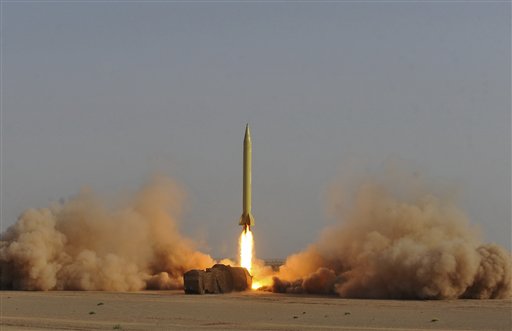 London – Iran has conducted covert tests of ballistic missiles capable of carrying nuclear warheads in addition to a 10-day program of public military maneuvers, Britain alleged on Wednesday.
London – Iran has conducted covert tests of ballistic missiles capable of carrying nuclear warheads in addition to a 10-day program of public military maneuvers, Britain alleged on Wednesday.
Subscribe to our Daily Roundup Email
Foreign Secretary William Hague told the House of Commons that there had been secret experiments with nuclear-capable missiles, but did not specify precisely when the tests had taken place.
Iran has “been carrying out covert ballistic missiles tests and rocket launches, including testing missiles capable of delivering a nuclear payload,” Hague said.
Britain believes Tehran has conducted at least three secret tests of medium-range ballistic missiles since October, amid an apparent escalation of its nuclear program and increased scrutiny from the International Atomic Energy Agency.
A U.N. Panel of Experts report leaked to the media last month reported that Iran conducted secret ballistic missile tests in October and February.
During the tests, the report said, Iran launched a liquid-fueled Shahab 3 missile, with a range of 560 miles (900 kilometers), and one or two solid-fueled Sejil 2 missiles, with a range of 1,240 miles (2,000 kilometers).
Both missiles are believed to be capable of carrying a nuclear warhead, the U.N. experts said. They did not say if the tests were successful, or provide other details.
The Washington-based Institute for Science and International Security, an arms control group, raised concerns about the secret tests in a posting on its website.

The group pointed out that a 2010 U.N. Security Council resolution prohibits Iran from “any activity related to ballistic missiles capable of delivering nuclear weapons, including launches…”
Iran is currently displaying its military hardware in a series of war games in an apparent show of openness, and on Tuesday fired 14 missiles in public tests.
However, the U.K. believes that the covert missile tests show Iran’s leaders are seeking to avoid scrutiny over the real extent of their weapons programs.
“On the back of the recent IAEA report and the unanswered questions about its nuclear program, they only serve to undermine further Iran’s claims that its nuclear program is entirely for civilian use,” said a Foreign Office spokesman, on customary condition of anonymity in line with policy.
An IAEA report last month listed “high-voltage firing and instrumentation for explosives testing over long distances and possibly underground” as one of seven “areas of concern” that Iran may be conducting clandestine nuclear weapons work.
Hague also said Britain was concerned over Tehran’s decision to increase its capacity to enrich uranium to a higher level at the Fordo site near the holy city of Qom in central Iran.

“It has announced that it intends to triple its capacity to produce 20 percent enriched uranium. These are enrichment levels far greater that is needed for peaceful nuclear energy,” Hague said.
Low-enriched uranium — at around 3.5 percent — can be used to fuel a reactor to generate electricity, while uranium enriched to around 90 percent purity can be used to develop a nuclear warhead.
Enriching to 90 percent can be done much more easily from material enriched to 20 percent purity than from low-enriched material.
Some Western officials claim Iran is accelerating its attempts to produce a nuclear weapon, partly because leaders have been shaken by protests against authoritarian regimes across the Middle East.
Iran and the West remain in dispute over its nuclear program. The U.S. and its allies insist it is aimed at developing atomic weapons — a charge Iran rejects.
“We will maintain and continue to increase pressure on Iran to negotiate an agreement on their nuclear program,” Hague said.
Hague also condemned Tehran over its support of the violent crackdown on anti-regime demonstrations in Syria.
“Iran continues to connive in the suppression of legitimate protest in Syria and to suppress protests at home,” he said.

well I guess it is not so secret if its being reported here